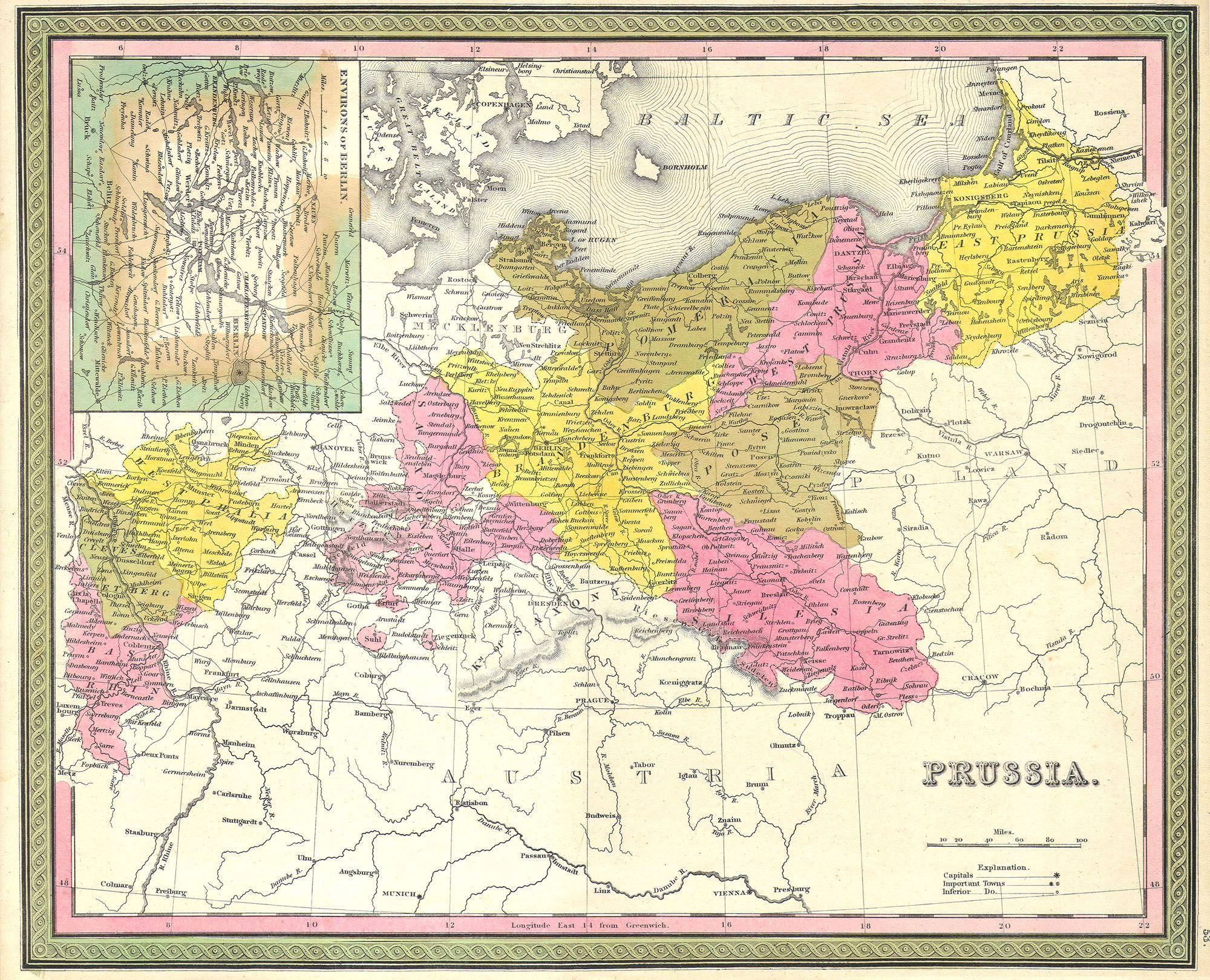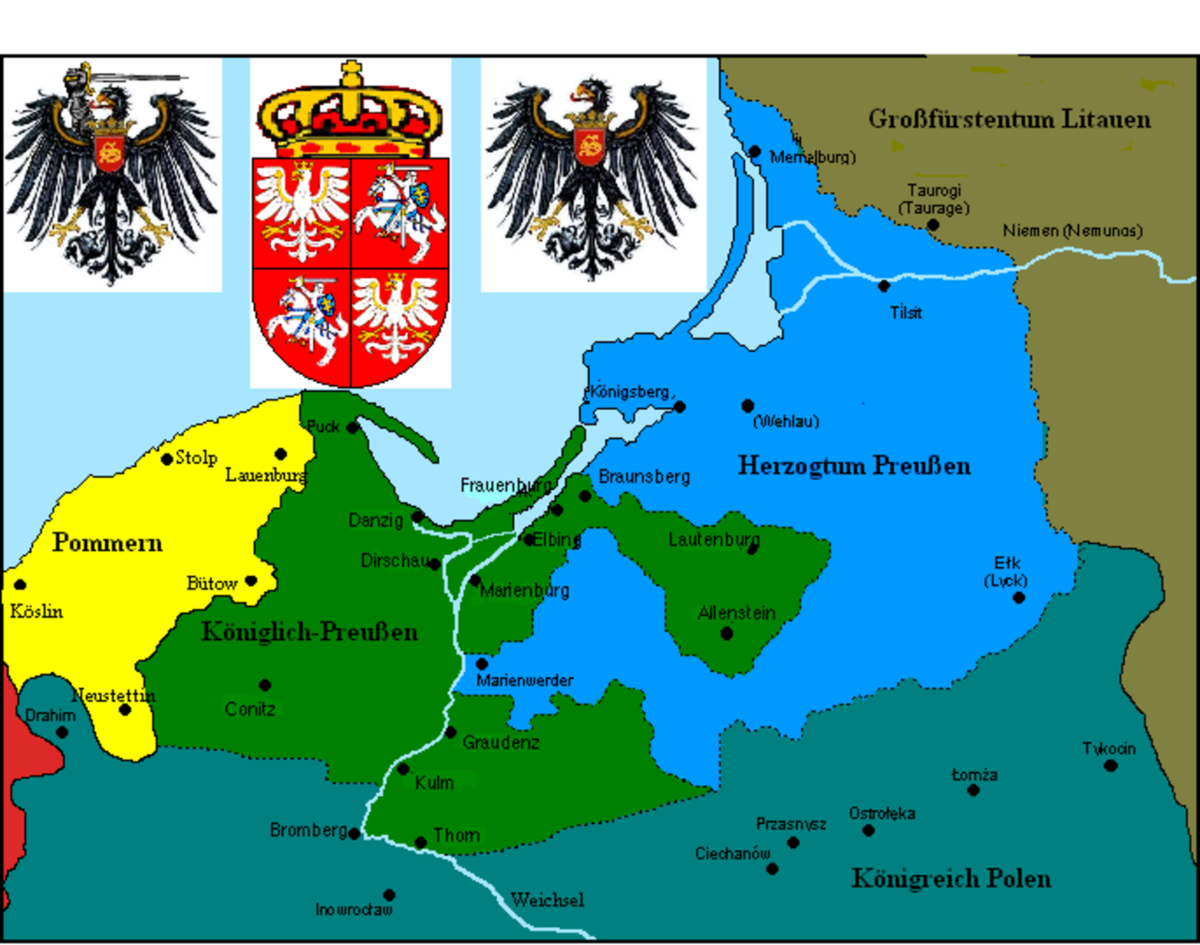Location of Prussia, Prussian states and countries
Prussia was a historical state that played a significant role in European history, particularly in the development of Germany. Here’s an overview of its location, historical countries, and its present status:
Location of Prussia
Prussia was located in Central and Eastern Europe.
At its height, it spanned across parts of modern-day Germany, Poland, Russia
(Kaliningrad Oblast), Lithuania, Denmark, Belgium, and the Czech Republic.
Its core territories were in the regions of Brandenburg (including Berlin) and
East Prussia (now divided between Poland, Russia, and Lithuania).
 Map of Prussia
(1850, Mitchell)
Map of Prussia
(1850, Mitchell)
Countries of Prussia (Historical Context)
Prussia was not a single country but a collection of territories under the control of the Prussian state, which was a dominant power in the German Confederation and later the German Empire. Key regions included:
- Brandenburg: The heart of Prussia, with Berlin as its capital.
- East Prussia: Located along the Baltic Sea, now part of Russia (Kaliningrad Oblast) and Poland.
- West Prussia: Now part of Poland.
- Silesia: Now divided between Poland, Germany, and the Czech Republic.
- Pomerania: Split between Germany and Poland.
- Rhineland: Part of modern-day Germany.
- Posen: Now part of Poland.
 Prussian
territories
Prussian
territories
Old Prussia (Pre-Modern Era)
- The original Prussia referred to the lands of the Baltic
Prussians, a pagan tribe conquered by the Teutonic Knights in
the 13th century.
- This area later became the Duchy of Prussia (1525) and then
the Kingdom of Prussia (1701).
Present Status
Prussia as a political entity no longer exists. It was
officially dissolved in 1947 after World War II by the Allied
powers.
Its territories are now part of several modern countries:
- Germany: Most of Brandenburg, Berlin, and parts of Rhineland.
- Poland: West Prussia, East Prussia (southern part), Silesia, and Pomerania.
- Russia: Kaliningrad Oblast (northern part of East Prussia).
- Lithuania: A small portion of East Prussia.
- Czech Republic: Part of Silesia.
- Denmark: A small region in Schleswig-Holstein.
- Belgium: A tiny portion of the Rhineland.
All Prussian rulers
The rulers of Prussia were part of the House of Hohenzollern, a dynasty that played a significant role in European history. Below is a list of all the rulers of Prussia, starting from the establishment of the Duchy of Prussia in 1525, through the Kingdom of Prussia, and ending with the abolition of the monarchy in 1918.
Dukes of Prussia (1525–1701)
- Albert (1525–1568) - First Duke of Prussia.
- Albert Frederick (1568–1618) - Son of Albert.
- John Sigismund (1618–1619) - Elector of Brandenburg, inherited Prussia.
- George William (1619–1640) - Son of John Sigismund.
- Frederick William (1640–1688) - Known as the "Great Elector."
- Frederick III (1688–1701) - Became King Frederick I of Prussia in 1701.
Kings of Prussia (1701–1918)
- Frederick I (1701–1713) - First King of Prussia.
- Frederick William I (1713–1740) - Known as the "Soldier King."
- Frederick II (Frederick the Great) (1740–1786) - One of Prussia's most famous rulers.
- Frederick William II (1786–1797) - Nephew of Frederick the Great.
- Frederick William III (1797–1840) - Ruled during the Napoleonic Wars.
- rederick William IV (1840–1861) - Oversaw the Revolutions of 1848.
- William I (1861–1888) - Became the first German Emperor in 1871.
- Frederick III (1888) - Ruled for only 99 days.
- William II (1888–1918) - Last King of Prussia and German Emperor; abdicated in 1918.
Legacy
- Prussia was initially a duchy under Polish suzerainty but became a sovereign kingdom in 1701.
- The Kingdom of Prussia played a central role in the unification of Germany in 1871.
- The monarchy was abolished in 1918 after Germany's defeat in World War I.
- Prussia’s influence is still felt in modern Germany, particularly in its military traditions, administrative systems, and cultural heritage.
- The term "Prussian" is often associated with discipline, efficiency, and militarism.
